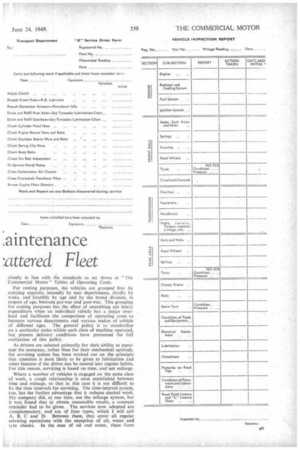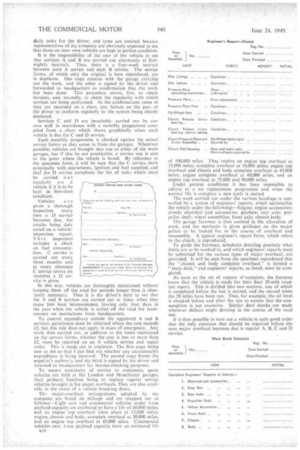PreventiI laintenance for :catered Fleet
Page 14

Page 15

Page 16

If you've noticed an error in this article please click here to report it so we can fix it.
In "The Commercial Motor" for March 259 S.T.R. dealt with a preventive maintenance problem concerned with a fleet of 185 vehicles scattered throughout the country. Mr. Thompson here outlines the scheme that he has in operation to meet conditions similar to those mentioned by S.T.R.
THE fleet of vehicles maintained by my company comprises 120 machines, and there are garage facilities in London and Manchester. The vehicle& in the fleet are divided up roughly as follows:-20 per cent. are 2-ton and 5-ton vans, principally of Ford Thames make, 30 per cent. are 10 hip, and 16 h.p. cars, mostly Ford and Austin, with a balance of 10-cwt. vans (Ford, Morris and Jowett).
To provide for quick identification, the vehicles are given a fleet number, which also indicates their payload capacity. For example, the 10-cwt. vans are given numbers from 100 to 199, and the 4-5-tonners from 800 to 899. When a nought is added after the first digit the payload capacity in cwt. is indicated.
The vehicles, of which one-third are of pre-war make, are operated from bases spread from Glasgow and Edinburgh in the north to Rochester and Southampton in the south, and Bristol and Bangor in the west. The annual mileage is at present nearly 1,250,000.
Many of these machines, partieularly those in the 10-cwt. class, do not come in daily, or even weekly, to the company's 'main garages in London and Manchester. Nevertheless, a degree of availability of 93 per cent, has been attained despite delays in obtaining spare parts. Inability to obtain spares has frequently accounted for 70 per cent, of the total time spent by a vehicle in the workshop for a straightforward major overhaul. Incidentally, costs have been kept
closely in line with the standards as set down in " he Commercial Motor" Tables of Operating Costs.
For costing purposes, the vehicles are grouped first by carrying capacity, secondly by user departments, thirdly by make, and fourthly by age and by the broad division, in respect of age, between pre-war and post-war. This grouping for costing purposes has the effect of smoothing out heavy expenditure when an individual vehicle has a major overhaul and facilitates the comparison of operating costs as between various departments and various makes of vehicle of different ages. The general policy is to standardize on a particular make within each class of machine operated, but present delivery conditions have prevented the full realization of this policy.
As drivers are selected primarily for their ability to represent the company, rather than for their mechanical aptitude, the servicing system has been worked out on the principle that attention is most likely to be given to lubrication and other features if the driver can be steered into regular habits. For this reason, servicing is based on time, and not mileage.
Where a number of vehicles is engaged on the same class of work, a rough relationship is soon established between time and mileage, so that in this case it is not difficult to fix the time intervals for servicing. The time-interval system, too, has the further advantage that it reduces clerical work. My company did, at one time, use the mileage system, but it was found that to obtain reasonable results, a constant reminder had to be given. The services now adopted are complementary, and are of four types, which 1 will call A, B, C and D. Between them, they cover all regular servicing operations with the exception of oil, water and tyre checks. In the ease of oil and water, these form
daily tasks for the driver, and tyres are omitted because representatives of my company are obviously expected to see that those on their own vehicles are kept hi perfect condition:
It is the responsibility of the user of the vehicle to see that services A and B are carried out alternately at fortnightly intervals. Thus, there is a fOur-Week interval between each A service and each B service.The service ,forrns, of which only the original is here reproduced, are in duplicate. One cony remains with the garage carrying out the work, and the other is signed by the driver and forwarded to headquarters as confirmation that. the work has been done. This procedure serves, first, to check invoices, and, secondly, to check the regularity with which services are being performed. As the confirmations come in they are recorded on a chart, any failure on the partof the driver to conform regularly to the system being clearly disclosed.
Service's C and D are invariably carried out by our own staff in accordance with a monthly programme compiled from a chart which shows graphically when -each vehicle is due for C and D service.
Each monthly programme is checked against the actual service forms as they come in from the garages. Whenever possible, vehicles are brought into one or other of the main garages, but if this be not practicable, a service van is sent to the point where the vehicle is based. By reference to the specimen form, it will be seen that the C service deals principally with instruments, ignition and fuel supplied, and that' the 0 service completes the list of tasks which must be carried o u t regularly on a vehicle if it is to be kept in first-class condition.
Vehicles a cc given a thorough inspection every time a .D service becomes due, the results being duly noted on a vehicleinspection report. This inspection includes cheek on fuel consumption. C service is carried out every three months and at every alternate C service (every six mOnths) a El service is given.
In this way, vehicles are thoroughly maintained without keeping them off the road for periods longer than is absolutely necessary. Thus it is the driver's duty to see that the A and B services are carried out at times when they cause him least inconvenience, leaving only fontdays in the year when the vehicle is called off the road for maintenance on instructions from headquarters.
To control expenditure outside the approved A and B services, permission mot be obtained where the cost exceeds £2, but this rule does not apply in cases of emergency. Any work thus carried out, in addition to the items mentioned on the service forms, whether the cost is less or more than £2, must be reported on an A vehicle service and repair order. This is made out in triplicate: The first copy being sent to me so that I can find out whether any unreasonable expenditure is being incurred. The second copy forms the supplier's authority and the third is signed by the driver and returned to headquarters for invoice-checking purposes.
To ensure continuity of service to customers, spare vehicles are held at the London and Manchester garages, their primary function being to replace regular service vehicles brought in for major overhauls. They are also available in the event of a vehicle breaking down.
The. major-overhaul arrangements adopted by my company are based on mileage and are mapped out as follows:—Light cars and commercial vehicles under 1-ton payload capacity are estirnated to have a life of 60,000 miles, and an engine top overhaul takes place at 15,000 miles; engine, chassis and body, complete overhaul at 30,000 miles, and an engine top overhaul at 45,000 miles. Commercial vehicles over 1-ton payload capacity have an estimated life
VEHICLE SERVICE AND REPAIR ORDER '
Pitate 4111 oet the lelicoons -.oak atUi item, ...tided to en
•
Fleet No
Date Torieard th.s copy for Lk attention of the Transport Manstgor IMMEDIATELY the. work Ii put in hand. Only In an emergency num
c-npancliturc In txcns of L2 be PrR.uri oithunt dpvproldi hoog obtained. Icor. -nitlatIld live been mended-to.
O ste Siortuso . lot Sniior
• vENCLE COLLECTED.
D ice . Stgnature tor Tyrreoles Ltd.
of 100,003 miles: They receive an engine top overhaul at 15,000 miles; complete overhaul at 30,000 miles; engine top overhaul and chassis and body complete overhaul at 45,000 miles; engine complete overhaul at 60,000 miles, and an engine top overhaul at 75,000 and 90,000 miles, Under present conditions it has been impossible to adhere to a set, replacement programme and when the normal life is complete a new cycle is started.
The work carried out under the various headings is controlled by a system of engineers' reports, which sectionalize the vehicle under the following:—Engine; engine accessories; clutch; electrical and accessories; gearbox; rear axle; propeller shaft; wheel assemblies; front axle; chassis body.
The garage foreman is thus assisted in the allocation of work, and the mechanic is given guidance on the major points to be looked for in the course of overhaul and reassembly. A typical engineer's report form, which refers to the clutch, is reproduced.
To guide the foreman, schedules detailing precisely what limits are to be worked to, and which engineers' reports must be submitted for the various types of major overhaul, are provided. It will be seen from the specimen reproduced that the "chassis and body complete overhaul" is termed a " main dock," and engineers' reports, as listed, must be completed.
As soon as the set of reports isecomplete, the foremen know that the vehicle is ready for their final 20-mile roadtest report. This-is divided into two sections, one of which is completed before the test is started, and the second when the 20 miles have been run. Thus, for example, the oil level is checked before and after the run to ensure that the consumption is not excessive. Similar dual checks are made wherever defects' might develop in the course of the road test.
It is thus possible to turn out a vehicle, in such good order that the only attention that should be required before the next major overhaul becomes due is regular A, B, C and D service.




























